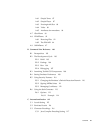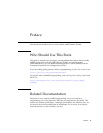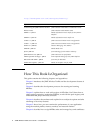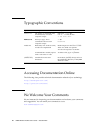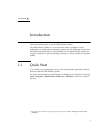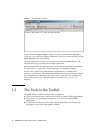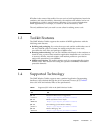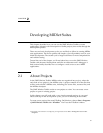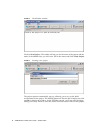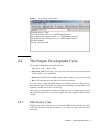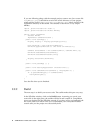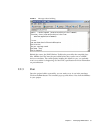
Chapter 1 Introduction 3
KToolbar is the center of the toolkit. You can use it to build applications, launch the
emulator, and start the utilities. Alternately, the emulator and utilities can be run
by themselves, which is useful in many situations. If you want to demonstrate
MIDP applications, for example, it’s useful to run the emulator by itself.
The only additional tool you need is a text editor for editing source code.
1.3 Toolkit Features
The J2ME Wireless Toolkit supports the creation of MIDP applications with the
following main features:
■ Building and packaging: You write the source code and the toolkit takes care of
the rest. With the push of a button, the toolkit compiles the source code,
preverifies the class files, and packages a MIDlet suite.
■ Running and monitoring: You can run a MIDlet suite directly in the emulator or
install it using a process that resembles application installation on a real device.
A memory monitor, network monitor, and method profiler are provided to
analyze the operation of your MIDlets.
■ MIDlet suite signing: The toolkit contains tools for cryptographically signing
MIDlet suites. This is useful for testing the operation of MIDlets in different
protection domains.
1.4 Supported Technology
The J2ME Wireless Toolkit supports many standard Application Programming
Interfaces (APIs) defined through the Java Community Process (JCP). TABLE 1
shows the APIs and includes links to the specifications.
TABLE 1 Supported JCP APIs in the J2ME Wireless Toolkit
JSR
API
Name
URL
JSR 139
CLDC 1.1
Connected Limited Device Configuration
http://jcp.org/en/jsr/detail?id=139
JSR 118
MIDP 2.0
Mobile Information Device Profile
http://jcp.org/en/jsr/detail?id=118
JSR 185
JTWI 1.0
Java Technology for the Wireless Industry
http://jcp.org/en/jsr/detail?id=185
JSR 205
WMA 2.0
Wireless Messaging API
http://jcp.org/en/jsr/detail?id=205



